Internet of Things: Communication Protocols and Technical Challenges
VerifiedAdded on 2023/05/30
|10
|2295
|353
AI Summary
This report highlights the importance of IoT in this modern generation and technologies and network protocols used by IoT for communication purpose. It explains the concept of an internet of thing, communication protocols used by IoT and technical challenges faced by this technology.
Contribute Materials
Your contribution can guide someone’s learning journey. Share your
documents today.

INTERNET OF THING
0
Internet of Thing
0
Internet of Thing
Secure Best Marks with AI Grader
Need help grading? Try our AI Grader for instant feedback on your assignments.

INTERNET OF THING
1
Table of Contents
Introduction...........................................................................................................................................2
Data communication protocols.............................................................................................................2
Satellite..............................................................................................................................................2
Advantages....................................................................................................................................2
Disadvantages................................................................................................................................3
Wi-Fi..................................................................................................................................................3
Advantages....................................................................................................................................3
Disadvantages................................................................................................................................3
Radiofrequency.................................................................................................................................3
Advantages....................................................................................................................................3
Disadvantages................................................................................................................................4
Application of the internet of things.....................................................................................................4
Technical challenges faced by IoT in creating smart home devices.......................................................5
Security challenges............................................................................................................................5
Privacy challenges..............................................................................................................................6
Connectivity challenges.....................................................................................................................6
Compatibility and longevity issue......................................................................................................6
Comparison of the communication technologies used by IoT...............................................................7
Conclusion.............................................................................................................................................7
References.............................................................................................................................................9
1
Table of Contents
Introduction...........................................................................................................................................2
Data communication protocols.............................................................................................................2
Satellite..............................................................................................................................................2
Advantages....................................................................................................................................2
Disadvantages................................................................................................................................3
Wi-Fi..................................................................................................................................................3
Advantages....................................................................................................................................3
Disadvantages................................................................................................................................3
Radiofrequency.................................................................................................................................3
Advantages....................................................................................................................................3
Disadvantages................................................................................................................................4
Application of the internet of things.....................................................................................................4
Technical challenges faced by IoT in creating smart home devices.......................................................5
Security challenges............................................................................................................................5
Privacy challenges..............................................................................................................................6
Connectivity challenges.....................................................................................................................6
Compatibility and longevity issue......................................................................................................6
Comparison of the communication technologies used by IoT...............................................................7
Conclusion.............................................................................................................................................7
References.............................................................................................................................................9
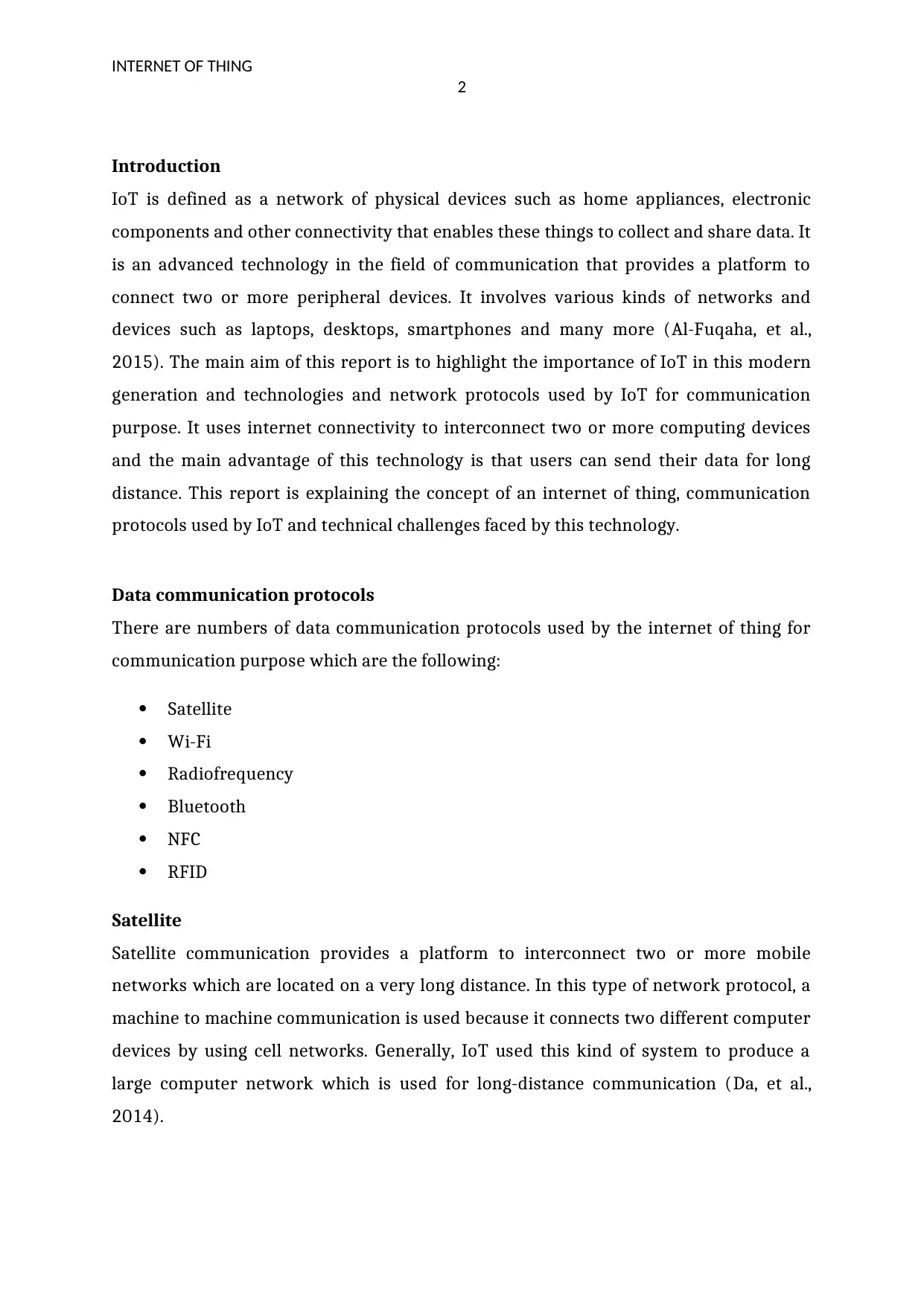
INTERNET OF THING
2
Introduction
IoT is defined as a network of physical devices such as home appliances, electronic
components and other connectivity that enables these things to collect and share data. It
is an advanced technology in the field of communication that provides a platform to
connect two or more peripheral devices. It involves various kinds of networks and
devices such as laptops, desktops, smartphones and many more (Al-Fuqaha, et al.,
2015). The main aim of this report is to highlight the importance of IoT in this modern
generation and technologies and network protocols used by IoT for communication
purpose. It uses internet connectivity to interconnect two or more computing devices
and the main advantage of this technology is that users can send their data for long
distance. This report is explaining the concept of an internet of thing, communication
protocols used by IoT and technical challenges faced by this technology.
Data communication protocols
There are numbers of data communication protocols used by the internet of thing for
communication purpose which are the following:
Satellite
Wi-Fi
Radiofrequency
Bluetooth
NFC
RFID
Satellite
Satellite communication provides a platform to interconnect two or more mobile
networks which are located on a very long distance. In this type of network protocol, a
machine to machine communication is used because it connects two different computer
devices by using cell networks. Generally, IoT used this kind of system to produce a
large computer network which is used for long-distance communication (Da, et al.,
2014).
2
Introduction
IoT is defined as a network of physical devices such as home appliances, electronic
components and other connectivity that enables these things to collect and share data. It
is an advanced technology in the field of communication that provides a platform to
connect two or more peripheral devices. It involves various kinds of networks and
devices such as laptops, desktops, smartphones and many more (Al-Fuqaha, et al.,
2015). The main aim of this report is to highlight the importance of IoT in this modern
generation and technologies and network protocols used by IoT for communication
purpose. It uses internet connectivity to interconnect two or more computing devices
and the main advantage of this technology is that users can send their data for long
distance. This report is explaining the concept of an internet of thing, communication
protocols used by IoT and technical challenges faced by this technology.
Data communication protocols
There are numbers of data communication protocols used by the internet of thing for
communication purpose which are the following:
Satellite
Wi-Fi
Radiofrequency
Bluetooth
NFC
RFID
Satellite
Satellite communication provides a platform to interconnect two or more mobile
networks which are located on a very long distance. In this type of network protocol, a
machine to machine communication is used because it connects two different computer
devices by using cell networks. Generally, IoT used this kind of system to produce a
large computer network which is used for long-distance communication (Da, et al.,
2014).
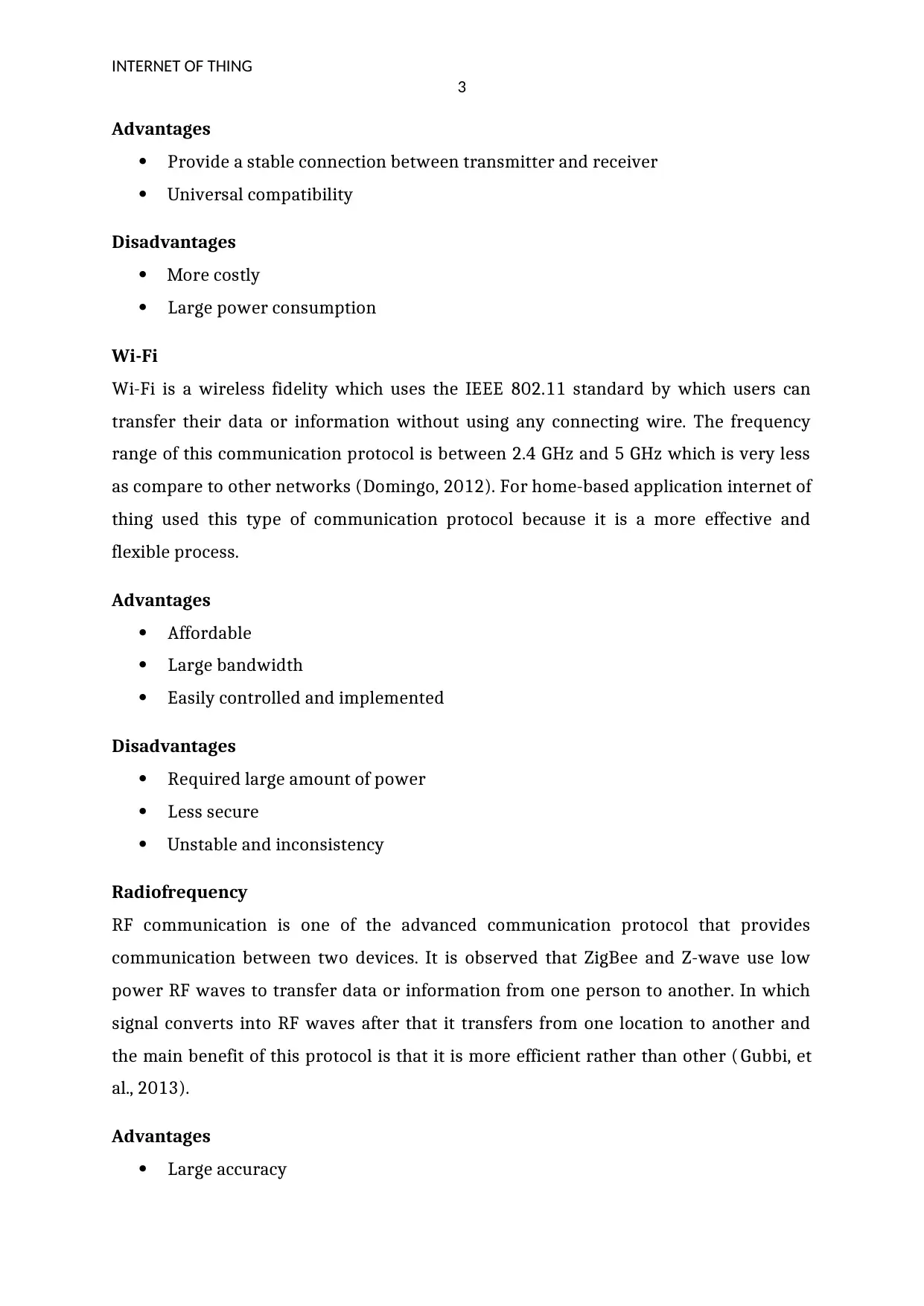
INTERNET OF THING
3
Advantages
Provide a stable connection between transmitter and receiver
Universal compatibility
Disadvantages
More costly
Large power consumption
Wi-Fi
Wi-Fi is a wireless fidelity which uses the IEEE 802.11 standard by which users can
transfer their data or information without using any connecting wire. The frequency
range of this communication protocol is between 2.4 GHz and 5 GHz which is very less
as compare to other networks (Domingo, 2012). For home-based application internet of
thing used this type of communication protocol because it is a more effective and
flexible process.
Advantages
Affordable
Large bandwidth
Easily controlled and implemented
Disadvantages
Required large amount of power
Less secure
Unstable and inconsistency
Radiofrequency
RF communication is one of the advanced communication protocol that provides
communication between two devices. It is observed that ZigBee and Z-wave use low
power RF waves to transfer data or information from one person to another. In which
signal converts into RF waves after that it transfers from one location to another and
the main benefit of this protocol is that it is more efficient rather than other ( Gubbi, et
al., 2013).
Advantages
Large accuracy
3
Advantages
Provide a stable connection between transmitter and receiver
Universal compatibility
Disadvantages
More costly
Large power consumption
Wi-Fi
Wi-Fi is a wireless fidelity which uses the IEEE 802.11 standard by which users can
transfer their data or information without using any connecting wire. The frequency
range of this communication protocol is between 2.4 GHz and 5 GHz which is very less
as compare to other networks (Domingo, 2012). For home-based application internet of
thing used this type of communication protocol because it is a more effective and
flexible process.
Advantages
Affordable
Large bandwidth
Easily controlled and implemented
Disadvantages
Required large amount of power
Less secure
Unstable and inconsistency
Radiofrequency
RF communication is one of the advanced communication protocol that provides
communication between two devices. It is observed that ZigBee and Z-wave use low
power RF waves to transfer data or information from one person to another. In which
signal converts into RF waves after that it transfers from one location to another and
the main benefit of this protocol is that it is more efficient rather than other ( Gubbi, et
al., 2013).
Advantages
Large accuracy
Secure Best Marks with AI Grader
Need help grading? Try our AI Grader for instant feedback on your assignments.
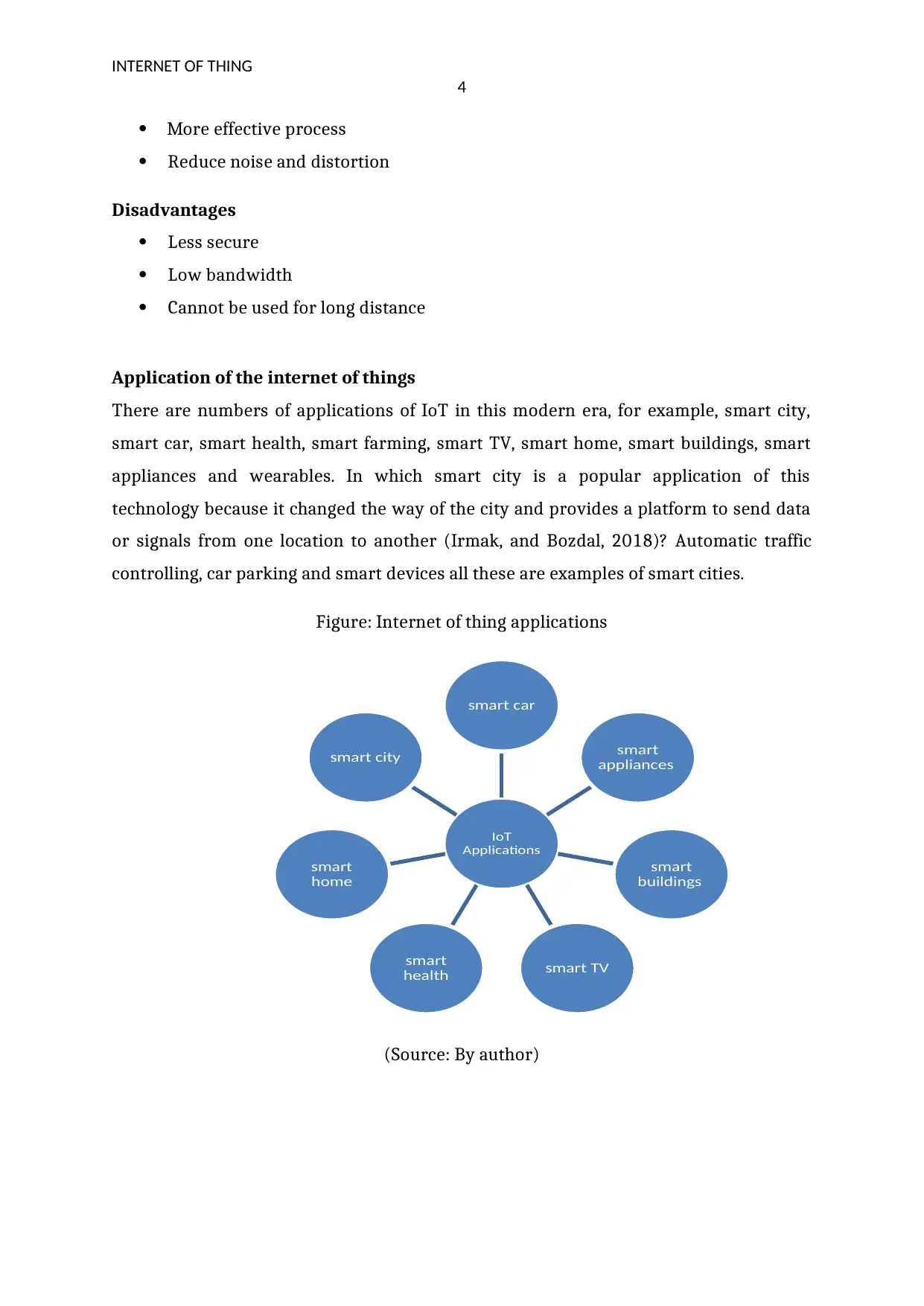
INTERNET OF THING
4
More effective process
Reduce noise and distortion
Disadvantages
Less secure
Low bandwidth
Cannot be used for long distance
Application of the internet of things
There are numbers of applications of IoT in this modern era, for example, smart city,
smart car, smart health, smart farming, smart TV, smart home, smart buildings, smart
appliances and wearables. In which smart city is a popular application of this
technology because it changed the way of the city and provides a platform to send data
or signals from one location to another (Irmak, and Bozdal, 2018)? Automatic traffic
controlling, car parking and smart devices all these are examples of smart cities.
Figure: Internet of thing applications
(Source: By author)
IoT
Applications
smart car
smart
appliances
smart
buildings
smart TV
smart
health
smart
home
smart city
4
More effective process
Reduce noise and distortion
Disadvantages
Less secure
Low bandwidth
Cannot be used for long distance
Application of the internet of things
There are numbers of applications of IoT in this modern era, for example, smart city,
smart car, smart health, smart farming, smart TV, smart home, smart buildings, smart
appliances and wearables. In which smart city is a popular application of this
technology because it changed the way of the city and provides a platform to send data
or signals from one location to another (Irmak, and Bozdal, 2018)? Automatic traffic
controlling, car parking and smart devices all these are examples of smart cities.
Figure: Internet of thing applications
(Source: By author)
IoT
Applications
smart car
smart
appliances
smart
buildings
smart TV
smart
health
smart
home
smart city

INTERNET OF THING
5
Technical challenges faced by IoT in creating smart home devices
The internet of thing is an advanced technology which is used for controlling and
monitors purpose. This technology involves numbers of electronics devices, sensors and
smart devices to control the home appliances system such as embedded, temperature
sensor and many more (Loo, Mauri, and Ortiz, 2016). Internet of thing faced many
challenges during the generation of smart devices for home which are the following:
Security challenges
Connectivity challenges
Privacy challenges
Compatibility and longevity challenges
Security challenges
Security is a very serious problem on the internet of thing due to which users can lose
their private details and information. The problem of baby monitor, drug infusion
pumps, hacking of cameras, smart fridges, and malware attacks all these are caused by
IoT technology. In which numbers of networks connected with two or more peripheral
devices that increase various malicious attacks because hackers target on computer
networks (Madakam, Ramaswamy, and Tripathi, 2015). It is studied that hackers first
identify the location and authentic servers and produce malware traffic to block the
user’s mobile networks and other devices.
Privacy challenges
Lack of privacy is also a very common issue occurs in the internet of thing and it is
observed that internet of thing uses wireless networks to transfer data which are very
less private. Data generation in a single appliance is very less sensitive and when it
combines with other smart devices they reduce the privacy of user's data. In many
cases, hackers produce malicious software to encrypt the communication system by
which consumers can lose their private information like bank details, and many more
(Perera, Liu, and Jayawardena, 2015).
Connectivity challenges
Connecting numbers of devices with each other is one of the biggest challenges in the
internet of thing and it is very difficult to make a high-level communication system. In
this modern generation, users transfer their data or signals by using computer
5
Technical challenges faced by IoT in creating smart home devices
The internet of thing is an advanced technology which is used for controlling and
monitors purpose. This technology involves numbers of electronics devices, sensors and
smart devices to control the home appliances system such as embedded, temperature
sensor and many more (Loo, Mauri, and Ortiz, 2016). Internet of thing faced many
challenges during the generation of smart devices for home which are the following:
Security challenges
Connectivity challenges
Privacy challenges
Compatibility and longevity challenges
Security challenges
Security is a very serious problem on the internet of thing due to which users can lose
their private details and information. The problem of baby monitor, drug infusion
pumps, hacking of cameras, smart fridges, and malware attacks all these are caused by
IoT technology. In which numbers of networks connected with two or more peripheral
devices that increase various malicious attacks because hackers target on computer
networks (Madakam, Ramaswamy, and Tripathi, 2015). It is studied that hackers first
identify the location and authentic servers and produce malware traffic to block the
user’s mobile networks and other devices.
Privacy challenges
Lack of privacy is also a very common issue occurs in the internet of thing and it is
observed that internet of thing uses wireless networks to transfer data which are very
less private. Data generation in a single appliance is very less sensitive and when it
combines with other smart devices they reduce the privacy of user's data. In many
cases, hackers produce malicious software to encrypt the communication system by
which consumers can lose their private information like bank details, and many more
(Perera, Liu, and Jayawardena, 2015).
Connectivity challenges
Connecting numbers of devices with each other is one of the biggest challenges in the
internet of thing and it is very difficult to make a high-level communication system. In
this modern generation, users transfer their data or signals by using computer
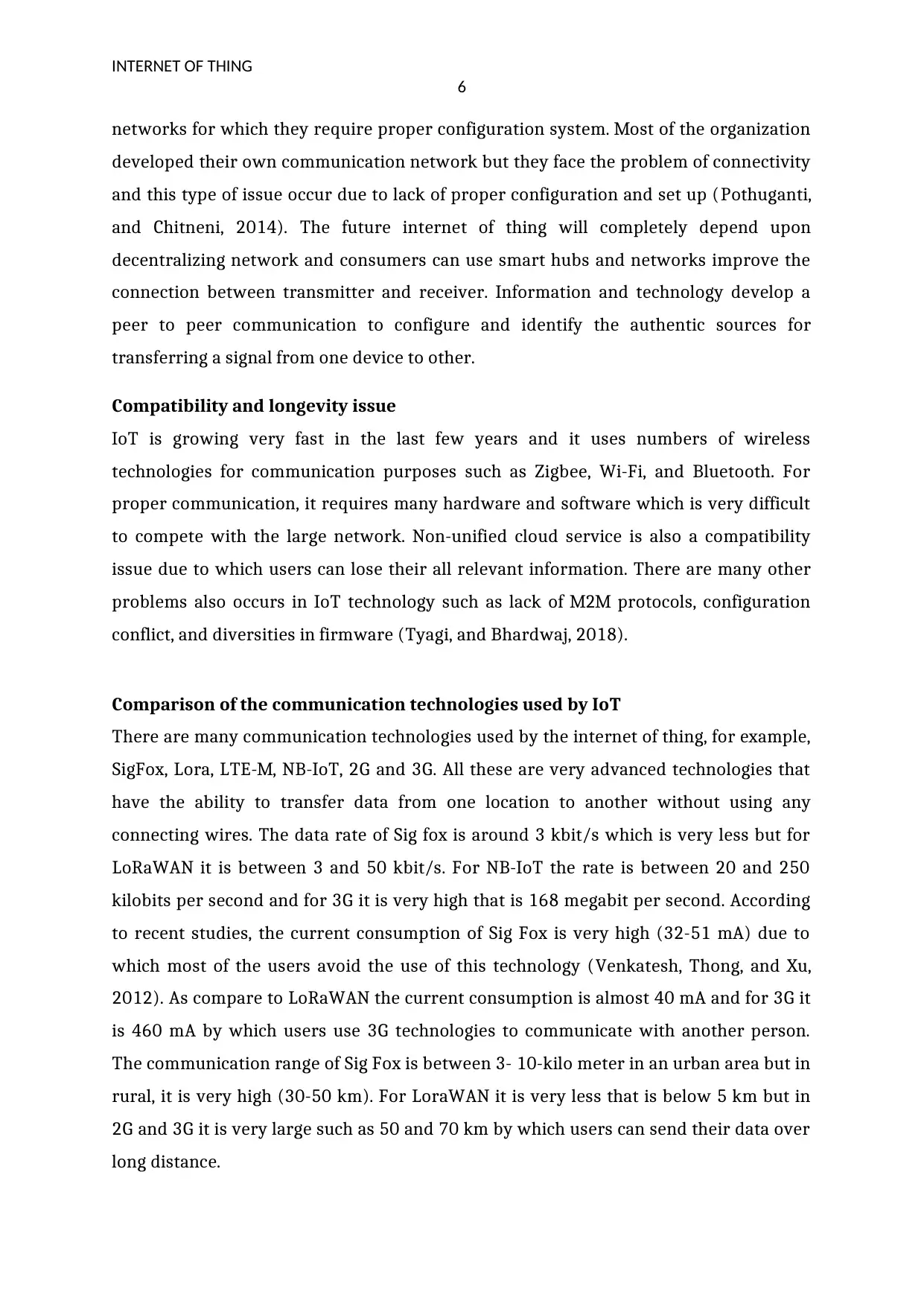
INTERNET OF THING
6
networks for which they require proper configuration system. Most of the organization
developed their own communication network but they face the problem of connectivity
and this type of issue occur due to lack of proper configuration and set up (Pothuganti,
and Chitneni, 2014). The future internet of thing will completely depend upon
decentralizing network and consumers can use smart hubs and networks improve the
connection between transmitter and receiver. Information and technology develop a
peer to peer communication to configure and identify the authentic sources for
transferring a signal from one device to other.
Compatibility and longevity issue
IoT is growing very fast in the last few years and it uses numbers of wireless
technologies for communication purposes such as Zigbee, Wi-Fi, and Bluetooth. For
proper communication, it requires many hardware and software which is very difficult
to compete with the large network. Non-unified cloud service is also a compatibility
issue due to which users can lose their all relevant information. There are many other
problems also occurs in IoT technology such as lack of M2M protocols, configuration
conflict, and diversities in firmware (Tyagi, and Bhardwaj, 2018).
Comparison of the communication technologies used by IoT
There are many communication technologies used by the internet of thing, for example,
SigFox, Lora, LTE-M, NB-IoT, 2G and 3G. All these are very advanced technologies that
have the ability to transfer data from one location to another without using any
connecting wires. The data rate of Sig fox is around 3 kbit/s which is very less but for
LoRaWAN it is between 3 and 50 kbit/s. For NB-IoT the rate is between 20 and 250
kilobits per second and for 3G it is very high that is 168 megabit per second. According
to recent studies, the current consumption of Sig Fox is very high (32-51 mA) due to
which most of the users avoid the use of this technology (Venkatesh, Thong, and Xu,
2012). As compare to LoRaWAN the current consumption is almost 40 mA and for 3G it
is 460 mA by which users use 3G technologies to communicate with another person.
The communication range of Sig Fox is between 3- 10-kilo meter in an urban area but in
rural, it is very high (30-50 km). For LoraWAN it is very less that is below 5 km but in
2G and 3G it is very large such as 50 and 70 km by which users can send their data over
long distance.
6
networks for which they require proper configuration system. Most of the organization
developed their own communication network but they face the problem of connectivity
and this type of issue occur due to lack of proper configuration and set up (Pothuganti,
and Chitneni, 2014). The future internet of thing will completely depend upon
decentralizing network and consumers can use smart hubs and networks improve the
connection between transmitter and receiver. Information and technology develop a
peer to peer communication to configure and identify the authentic sources for
transferring a signal from one device to other.
Compatibility and longevity issue
IoT is growing very fast in the last few years and it uses numbers of wireless
technologies for communication purposes such as Zigbee, Wi-Fi, and Bluetooth. For
proper communication, it requires many hardware and software which is very difficult
to compete with the large network. Non-unified cloud service is also a compatibility
issue due to which users can lose their all relevant information. There are many other
problems also occurs in IoT technology such as lack of M2M protocols, configuration
conflict, and diversities in firmware (Tyagi, and Bhardwaj, 2018).
Comparison of the communication technologies used by IoT
There are many communication technologies used by the internet of thing, for example,
SigFox, Lora, LTE-M, NB-IoT, 2G and 3G. All these are very advanced technologies that
have the ability to transfer data from one location to another without using any
connecting wires. The data rate of Sig fox is around 3 kbit/s which is very less but for
LoRaWAN it is between 3 and 50 kbit/s. For NB-IoT the rate is between 20 and 250
kilobits per second and for 3G it is very high that is 168 megabit per second. According
to recent studies, the current consumption of Sig Fox is very high (32-51 mA) due to
which most of the users avoid the use of this technology (Venkatesh, Thong, and Xu,
2012). As compare to LoRaWAN the current consumption is almost 40 mA and for 3G it
is 460 mA by which users use 3G technologies to communicate with another person.
The communication range of Sig Fox is between 3- 10-kilo meter in an urban area but in
rural, it is very high (30-50 km). For LoraWAN it is very less that is below 5 km but in
2G and 3G it is very large such as 50 and 70 km by which users can send their data over
long distance.
Paraphrase This Document
Need a fresh take? Get an instant paraphrase of this document with our AI Paraphraser
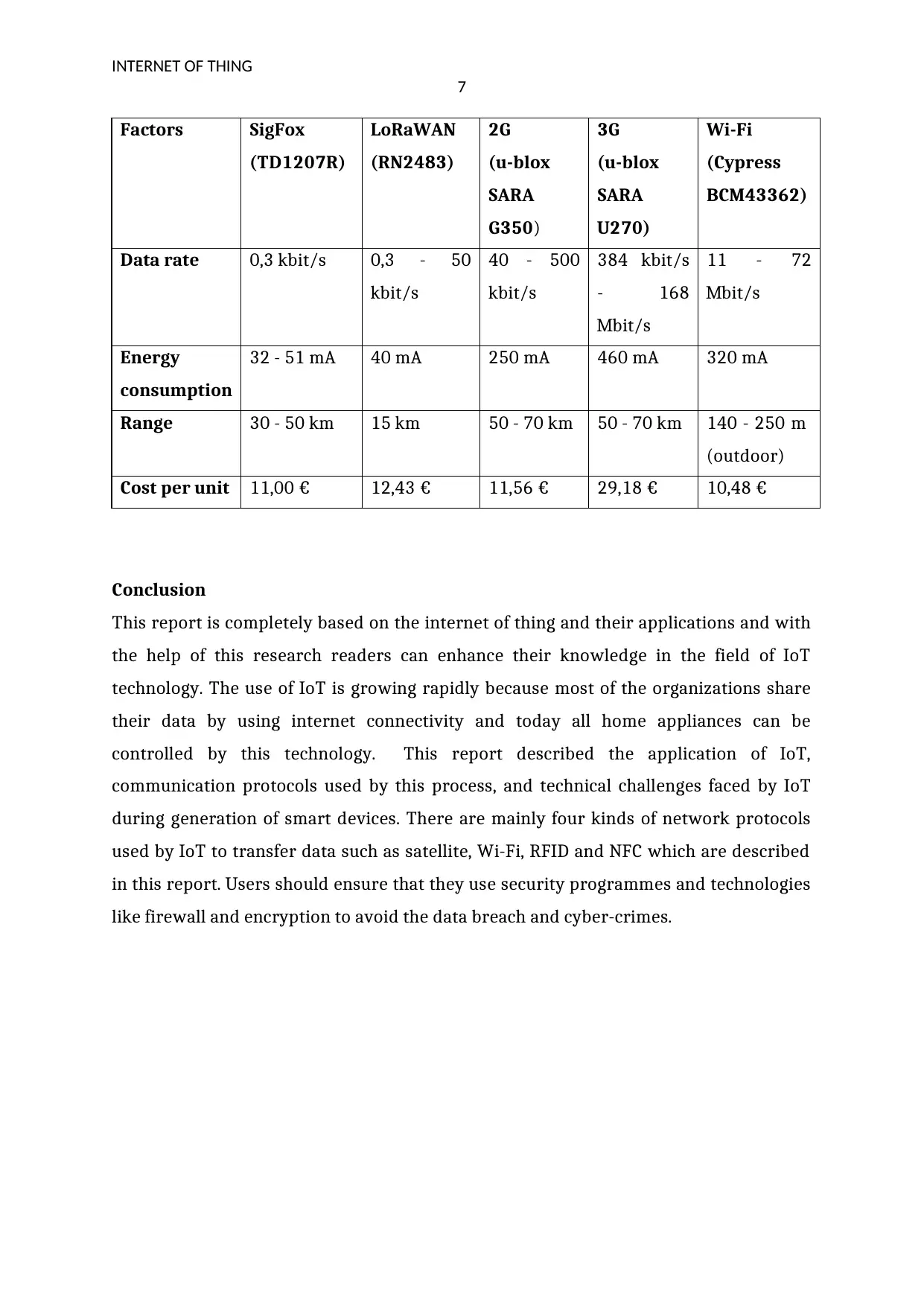
INTERNET OF THING
7
Factors SigFox
(TD1207R)
LoRaWAN
(RN2483)
2G
(u-blox
SARA
G350)
3G
(u-blox
SARA
U270)
Wi-Fi
(Cypress
BCM43362)
Data rate 0,3 kbit/s 0,3 - 50
kbit/s
40 - 500
kbit/s
384 kbit/s
- 168
Mbit/s
11 - 72
Mbit/s
Energy
consumption
32 - 51 mA 40 mA 250 mA 460 mA 320 mA
Range 30 - 50 km 15 km 50 - 70 km 50 - 70 km 140 - 250 m
(outdoor)
Cost per unit 11,00 € 12,43 € 11,56 € 29,18 € 10,48 €
Conclusion
This report is completely based on the internet of thing and their applications and with
the help of this research readers can enhance their knowledge in the field of IoT
technology. The use of IoT is growing rapidly because most of the organizations share
their data by using internet connectivity and today all home appliances can be
controlled by this technology. This report described the application of IoT,
communication protocols used by this process, and technical challenges faced by IoT
during generation of smart devices. There are mainly four kinds of network protocols
used by IoT to transfer data such as satellite, Wi-Fi, RFID and NFC which are described
in this report. Users should ensure that they use security programmes and technologies
like firewall and encryption to avoid the data breach and cyber-crimes.
7
Factors SigFox
(TD1207R)
LoRaWAN
(RN2483)
2G
(u-blox
SARA
G350)
3G
(u-blox
SARA
U270)
Wi-Fi
(Cypress
BCM43362)
Data rate 0,3 kbit/s 0,3 - 50
kbit/s
40 - 500
kbit/s
384 kbit/s
- 168
Mbit/s
11 - 72
Mbit/s
Energy
consumption
32 - 51 mA 40 mA 250 mA 460 mA 320 mA
Range 30 - 50 km 15 km 50 - 70 km 50 - 70 km 140 - 250 m
(outdoor)
Cost per unit 11,00 € 12,43 € 11,56 € 29,18 € 10,48 €
Conclusion
This report is completely based on the internet of thing and their applications and with
the help of this research readers can enhance their knowledge in the field of IoT
technology. The use of IoT is growing rapidly because most of the organizations share
their data by using internet connectivity and today all home appliances can be
controlled by this technology. This report described the application of IoT,
communication protocols used by this process, and technical challenges faced by IoT
during generation of smart devices. There are mainly four kinds of network protocols
used by IoT to transfer data such as satellite, Wi-Fi, RFID and NFC which are described
in this report. Users should ensure that they use security programmes and technologies
like firewall and encryption to avoid the data breach and cyber-crimes.

INTERNET OF THING
8
References
Al-Fuqaha, A., Guizani, M., Mohammadi, M., Aledhari, M. and Ayyash, M., (2015) Internet
of things: A survey on enabling technologies, protocols, and applications. IEEE
Communications Surveys & Tutorials, 17(4), pp.2347-2376.
Da Xu, L., He, W. and Li, S., (2014) Internet of things in industries: A survey. IEEE
Transactions on industrial informatics, 10(4), pp.2233-2243.
Domingo, M.C., (2012) An overview of the Internet of Things for people with disabilities.
Journal of Network and Computer Applications, 35(2), pp.584-596.
Gubbi, J., Buyya, R., Marusic, S. and Palaniswami, M., (2013) Internet of Things (IoT): A
vision, architectural elements, and future directions. Future generation computer
systems, 29(7), pp.1645-1660.
Irmak, E. and Bozdal, M., (2018) Internet of Things (IoT): The Most Up-To-Date
Challenges, Architectures, Emerging Trends and Potential Opportunities. population,
179(40), pp. 12-14.
Loo, J., Mauri, J.L. and Ortiz, J.H. eds., (2016) Mobile ad hoc networks: current status and
future trends. CRC Press.
Madakam, S., Ramaswamy, R. and Tripathi, S., (2015) Internet of Things (IoT): A
literature review. Journal of Computer and Communications, 3(05), p.164.
Perera, C., Liu, C.H. and Jayawardena, S., (2015) The emerging internet of things
marketplace from an industrial perspective: A survey. IEEE Transactions on Emerging
Topics in Computing, 3(4), pp.585-598.
Pothuganti, K. and Chitneni, A., (2014) A comparative study of wireless protocols:
Bluetooth, UWB, ZigBee, and Wi-Fi. Advance in Electronic and Electric Engineering, 4(6),
pp.655-662.
Tyagi, B. and Bhardwaj, P., (2018) IoT: Security Challenges. On Emerging Trends In
Information Technology (NCETIT’2018) with the theme-‘The Changing Landscape Of
Cyber Security: Challenges, 12(2), p.83.
Venkatesh, V., Thong, J.Y. and Xu, X., (2012) Consumer acceptance and use of
information technology: extending the unified theory of acceptance and use of
technology. MIS Quarterly, 14(4), pp.157-178.
8
References
Al-Fuqaha, A., Guizani, M., Mohammadi, M., Aledhari, M. and Ayyash, M., (2015) Internet
of things: A survey on enabling technologies, protocols, and applications. IEEE
Communications Surveys & Tutorials, 17(4), pp.2347-2376.
Da Xu, L., He, W. and Li, S., (2014) Internet of things in industries: A survey. IEEE
Transactions on industrial informatics, 10(4), pp.2233-2243.
Domingo, M.C., (2012) An overview of the Internet of Things for people with disabilities.
Journal of Network and Computer Applications, 35(2), pp.584-596.
Gubbi, J., Buyya, R., Marusic, S. and Palaniswami, M., (2013) Internet of Things (IoT): A
vision, architectural elements, and future directions. Future generation computer
systems, 29(7), pp.1645-1660.
Irmak, E. and Bozdal, M., (2018) Internet of Things (IoT): The Most Up-To-Date
Challenges, Architectures, Emerging Trends and Potential Opportunities. population,
179(40), pp. 12-14.
Loo, J., Mauri, J.L. and Ortiz, J.H. eds., (2016) Mobile ad hoc networks: current status and
future trends. CRC Press.
Madakam, S., Ramaswamy, R. and Tripathi, S., (2015) Internet of Things (IoT): A
literature review. Journal of Computer and Communications, 3(05), p.164.
Perera, C., Liu, C.H. and Jayawardena, S., (2015) The emerging internet of things
marketplace from an industrial perspective: A survey. IEEE Transactions on Emerging
Topics in Computing, 3(4), pp.585-598.
Pothuganti, K. and Chitneni, A., (2014) A comparative study of wireless protocols:
Bluetooth, UWB, ZigBee, and Wi-Fi. Advance in Electronic and Electric Engineering, 4(6),
pp.655-662.
Tyagi, B. and Bhardwaj, P., (2018) IoT: Security Challenges. On Emerging Trends In
Information Technology (NCETIT’2018) with the theme-‘The Changing Landscape Of
Cyber Security: Challenges, 12(2), p.83.
Venkatesh, V., Thong, J.Y. and Xu, X., (2012) Consumer acceptance and use of
information technology: extending the unified theory of acceptance and use of
technology. MIS Quarterly, 14(4), pp.157-178.

INTERNET OF THING
9
9
1 out of 10
Related Documents
Your All-in-One AI-Powered Toolkit for Academic Success.
+13062052269
info@desklib.com
Available 24*7 on WhatsApp / Email
![[object Object]](/_next/static/media/star-bottom.7253800d.svg)
Unlock your academic potential
© 2024 | Zucol Services PVT LTD | All rights reserved.





